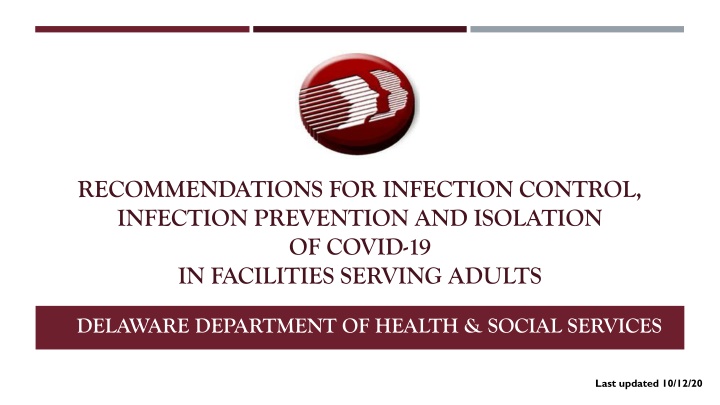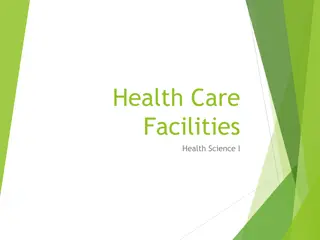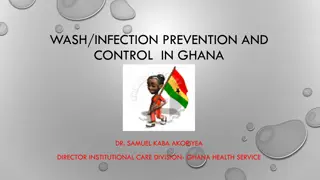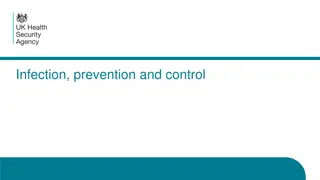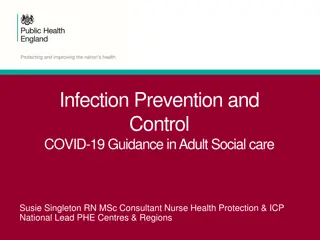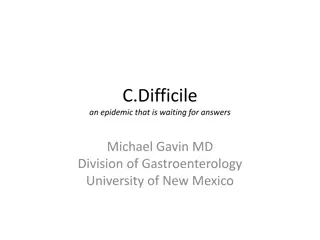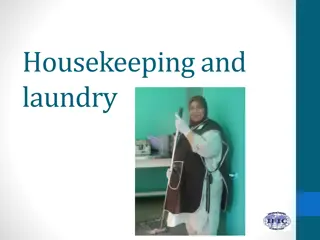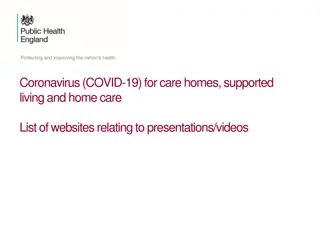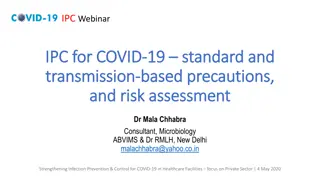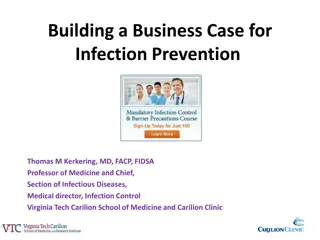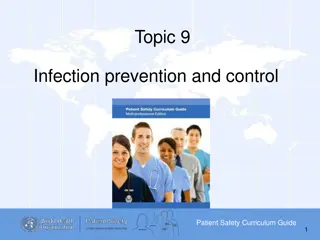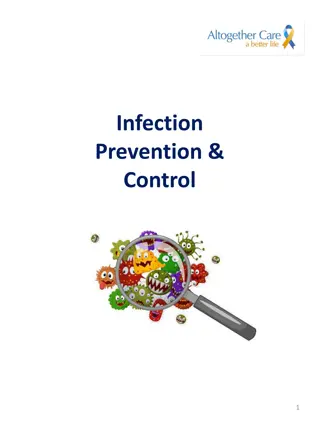Infection Control and Prevention Guidelines for COVID-19 in Adult Care Facilities
Review the recommendations for infection control, prevention, and isolation of COVID-19 in facilities serving adults provided by the Delaware Department of Health & Social Services. The guidelines cover core principles of infection prevention, general guidance for employees and patients, hand hygiene, PPE usage, isolation precautions, testing recommendations, patient transfers, and more. Emphasis is placed on screening, hand hygiene, face coverings, social distancing, signage, cleaning protocols, PPE use, resident cohorting, and testing requirements.
Download Presentation

Please find below an Image/Link to download the presentation.
The content on the website is provided AS IS for your information and personal use only. It may not be sold, licensed, or shared on other websites without obtaining consent from the author.If you encounter any issues during the download, it is possible that the publisher has removed the file from their server.
You are allowed to download the files provided on this website for personal or commercial use, subject to the condition that they are used lawfully. All files are the property of their respective owners.
The content on the website is provided AS IS for your information and personal use only. It may not be sold, licensed, or shared on other websites without obtaining consent from the author.
E N D
Presentation Transcript
RECOMMENDATIONS FOR INFECTION CONTROL, INFECTION PREVENTION AND ISOLATION OF COVID-19 IN FACILITIES SERVING ADULTS DELAWARE DEPARTMENT OF HEALTH & SOCIAL SERVICES Last updated 10/12/20 1
OBJECTIVES Review General Guidelines related to: Infection Prevention Core Principles of COVID 19 Visitation General Guidance (Employees, patient care, active screening, Health Care Workers, and Facility Guidelines ) Review Hand Hygiene Review PPE Usage (Video, Doffing, and Surgical Mask Recommendations/Use) Review of Isolation Precautions Review of Testing and Sample Collection Recommendations related to Patient Transfers and Discharges Provide SHOC and DHSS Resources 2
INFECTION PREVENTION CORE PRINCIPLES OF COVID 19 Screening of all who enter the facility for signs and symptoms of COVID-19 (e.g., temperature checks, questions or observations about signs or symptoms), and denial of entry of those with signs or symptoms Hand hygiene (use of alcohol-based hand rub is preferred) Face covering or mask (covering mouth and nose) Social distancing at least six feet between persons Instructional signage throughout the facility and proper visitor education on COVID-19 signs and symptoms, infection control precautions, and other applicable facility practices (e.g., use of face covering or mask, specified entries, exits and routes to designated areas, hand hygiene) 4
INFECTION PREVENTION CORE PRINCIPLES OF COVID 19 Cleaning and disinfecting high frequency touched surfaces in the facility often, and designated visitation areas after each visit Appropriate use of Personal Protective Equipment (PPE) Effective cohorting of residents (e.g., separate areas dedicated for COVID-19 care) Resident and staff testing conducted as required These core principles are consistent with the Centers for Disease Control and Prevention (CDC) guidance for nursing homes and should always be adhered to. 5
GENERAL GUIDANCE - UPDATED VISITATION Visitation can be conducted in different ways based on a facility s structure and residents needs. Options for visitation: Resident rooms Dedicated visitation spaces Outdoors Compassionate care situations 7
GENERAL GUIDANCE UPDATED VISITATION Advise visitors or any other individuals entering the facility to monitor for signs and symptoms of respiratory infection for 14 days after leaving the facility. They need to notify facility if symptoms occur individuals should report the date they were at the facility, individuals they were in contact with and locations in the facility they visited. Facilities should immediately screen all individuals who were in contact with the symptomatic individual Regardless of how visits are conducted, there are certain core principles and best practices that reduce the risk of COVID-19 transmission: 8
OUTDOOR VISITATION While taking a person-centered approach and adhering to the core principles of COVID-19 infection prevention, outdoor visitation is preferred and can also be conducted in a manner that reduces the risk of transmission. Outdoor visits pose a lower risk of transmission due to increased space and airflow. Therefore, all visits should be held outdoors whenever practicable. When conducting outdoor visitation, facilities should have a process to limit the number and size of visits occurring simultaneously to support safe infection prevention actions (e.g., maintaining social distancing). We also recommend reasonable limits on the number of individuals visiting with any one resident at the same time. 9
INDOOR VISITATION Indoor visitation may be permitted if: There have been no new onset of Covid -19 cases in the last 14 days and the facility is currently not conducting outbreak testing; Visitors must adhere to the core principles and staff should provide monitoring for those who may have difficulty adhering to core principles. 10
COMPASSIONATE CARE VISITS Compassionate care situations do not exclusively refer to end-of-life situations. Examples of compassionate care situations include, but are not limited to: A resident, who was living with their family before recently being admitted to a nursing home, is struggling with the change in environment and lack of physical family support. A resident who is grieving after a friend or family member recently passed away. A resident who needs cueing and encouragement with eating or drinking, previously provided by family and/or caregiver(s), is experiencing weight loss or dehydration. A resident, who used to talk and interact with others, is experiencing emotional distress, seldom speaking, or crying more frequently (when the resident had rarely cried in the past). 11
COMPASSIONATE CARE VISITS Compassionate care visits can be conducted by any individual that can meet the resident s needs, such as clergy or lay persons offering religious and spiritual support. Lastly, visits should always be conducted using Core principles of COVID 19 Infection Prevention. 12
REQUIRED VISITATION Residents who are on transmission-based precautions for COVID-19 should only receive visits that are virtual, through windows, or in-person for compassionate care situations, with adherence to transmission-based precautions. However, this restriction should be lifted once transmission-based precautions are no longer required per CDC guidelines, and other visits may be conducted as previously described. 13
GENERAL GUIDANCE IN LIEU OF VISITS In lieu of visits: Communicate through multiple means to inform individuals and nonessential health care personnel of the visitation restrictions, such as through signage at the entrance/exits, letters, emails, phone calls, and recorded messages for receiving calls. Offer alternative means of communication for people who would otherwise visit, such as virtual communications (phone, video-communication, etc.). Create/increase listserv communication to update families. Assign staff as primary contact to families for inbound calls and conduct regular outbound calls to keep families up to date. Offer a phone line with a voice recording updated at set times (e.g., daily) with the facility s general operating status, such as when it is safe to resume visits. 14
GENERAL GUIDANCE: EMPLOYEES, PATIENT CARE, ACTIVE SCREENING, HEALTH CARE WORKERS, AND FACILITY GUIDELINES 15
GENERAL GUIDANCE ALL EMPLOYEES Screen all staff at the beginning of each each shift, for fever and respiratory symptoms. o Actively take their temperature and document absence of shortness of breath, new or change in cough, and sore throat. o If ill, have them put on a facemask and return home to self-isolate. Individuals with fevers, other symptoms of COVID-19, or who are unable to demonstrate proper use of infection control techniques must be restricted from entry. Identify staff that work at multiple facilities (e.g., agency staff, regional or corporate staff, etc.). Actively screen and restrict them appropriately to ensure they do not place others at the facility at risk for COVID-19. Employees without direct care or resident contact should wear a non-medical mask. Dedicate staff and mobile equipment exclusively to a unit/wing to minimize exposures and transmission throughout the facility and in- between facilities o Limit staff working between wing/units as much as possible Practice Social Distancing and perform frequent hand hygiene! 16
GENERAL GUIDANCE PATIENT CARE Facilities experiencing an increased number of respiratory illnesses (regardless of suspected etiology) among residents or health care personnel should immediately contact the DPH Office of Disease Epidemiology for further guidance. Actively screen residents for fever and respiratory symptoms. Screen residents each day. If a resident has symptoms, collect a specimen for testing. Work to separate or cohort high-risk from lower risk residents. This also provides staff continuity with patients and reduces mixing between patients of different risk levels. Cluster care tasks (and medication delivery if possible) to decrease cross-contamination risk and frequent entry/exit into resident rooms. 17
ACTIVE SCREENING Screen everyone entering the health care facility for symptoms [cdc.gov] consistent with COVID-19. Actively take their temperature and document absence of symptoms consistent with COVID-19. Fever is either measured temperature >100.4 F or subjective fever. Ask them if they have been advised to self-quarantine because of exposure to someone with COVID-19. Properly manage anyone with symptoms of COVID-19 or who has been advised to self- quarantine. 18
ACTIVE SCREENING COVID -19 SYMPTOMS According to the CDC, COVID-19 symptoms [cdc.gov] may include, but are not limited to the following: Fever Cough Shortness of breath Headache New loss of taste or smell Congestion or runny nose Sore throat Diarrhea Myalgia (muscle aches, body aches) Tiredness and fatigue 19
ENTRY OF HEALTH CARE WORKERS AND OTHER PROVIDERS OF SERVICES Health care workers who are not employees of the facility but provide direct care to the facility s residents, such as hospice workers, Emergency Medical Services (EMS) personnel, laboratory technicians, radiology technicians, social workers, clergy etc., must be permitted to come into the facility as long as they are not subject to a work exclusion due to an exposure to COVID-19 or show signs or symptoms of COVID-19 after being screened. Note that EMS personnel do not need to be screened so they can attend to an emergency without delay. We remind facilities that all staff, including individuals providing services under arrangement as well as volunteers, should adhere to the core principles of COVID-19 infection prevention and must comply with COVID-19 testing requirements. 20
FEDERAL/STATE PERSONNEL Federal/State surveyors, investigators, ombudsmen, and other state personnel as approved by Department of Public Health and/or Division of Health Care Quality must be permitted to enter the Long-Term Care Facility. All such individuals are tested weekly for COVID 19 prior to LTC facility entry and in accordance with DPH/LTC vendor testing requirements. They should be screened by the facility the same as any individual entering the facility. 21
GENERAL GUIDANCE FACILITY OPERATIONS Review and revise how you interact with vendors, those delivering supplies, supplies delivered, agency staff, EMS personnel and equipment, transportation providers (e.g., when taking residents to offsite appointments, etc.), and other non-health care providers (e.g., food delivery, etc.), and take necessary actions to prevent any potential transmission. For example, have supply vendors drop off at a dedicated location (e.g., loading dock). Facilities can allow entry of these visitors if needed, as long as they are following the appropriate CDC guidelines for Transmission- Based Precautions. Increase availability and accessibility of alcohol-based hand rubs (AHRs) Reinforce strong hand-hygiene practices, tissues, no touch receptacles for disposal, and facemasks at health care facility entrances, waiting rooms, resident check-ins, etc. Ensure AHRs are accessible in all resident- care areas including inside and outside resident rooms 22
GENERAL GUIDANCE FACILITY OPERATIONS Increase signage for vigilant infection prevention, such as hand hygiene and cough etiquette Review or develop staff contingency plans to mitigate anticipated shortages. Provide additional work supplies to avoid sharing (e.g. pens, pads) and disinfect workplace areas (nurse stations, phones, internal radios, etc. 23
Handwashing: Resident and Staff APIC Video "Look At Me A hand washing video. https://www.youtube.com/watch?v=8WEUoPo8EjE Must Watch Video HAND HYGIENE 24
PPE USAGE 25
PERSONAL PROTECTIVE EQUIPMENT Employees providing direct resident contact should always wear procedural/surgical masks during their shift. Employees who do not have direct resident contact may not need to wear a medical mask in performing their normal duties but must always wear a cloth face covering during their shift. Consistent with aerosol precautions, employees should wear an N95 respirator while performing an aerosolizing procedure for presumed/known COVID-19 patient. A disposable facemask should be worn throughout your shift IF: NOT visibly soiled NOT torn or saturated NOT touched while delivering patient care If any of the above occur the mask should be discarded and replaced with a clean one. 26
PERSONAL PROTECTIVE EQUIPMENT Consistent with contact (gowns and gloves) and droplet (procedure/surgical mask, face shield/goggles) precautions, all other direct contact with residents who are presumed/known COVID-19 infected should not require an N95 respirator. Hand hygiene should be performed immediately after and before contact. Discard damaged, visibly soiled, torn or saturated masks. We recognize this is a departure from standard infection prevention; however, we find ourselves in extraordinary times and given current circumstances, we believe this deviation from standard policy is warranted. 27
Proper use of PPE/ Donning & Doffing PPE https://www.youtube.com/watch?v=84CydmuHXD8 PERSONAL PROTECTIVE EQUIPMENT Must Watch Video 28
PERSONAL PROTECTIVE EQUIPMENT SURGICAL MASK USE AND RE-USE To Doff facemask with intent to reuse: 1. Perform hand hygiene 2. Remove mask Remove procedure mask by holding the ear loops. The front is contaminated, so remove slowly and carefully. Remove surgical mask by untying lower ties FIRST. Untie upper ties last. The front is contaminated, so remove slowly and carefully. 3. After removing facemask, visually inspect for contamination, distortion in shape/form. If soiled, torn, or saturated the mask should be discarded. 4. If the facemask is NOT visibly soiled, torn, or saturated, facemasks should be carefully folded so that the outer surface is held inward and against itself to reduce contact with the outer surface during storage. The folded mask can be stored between uses in a clean sealable paper bag or breathable container. 5. Perform hand hygiene. 29
PERSONAL PROTECTIVE EQUIPMENT SURGICAL MASK USE AND RE-USE To Re-Don Mask: 1. Perform hand hygiene. 2. Grasp mask DO NOT touch the front of the mask. A disposable facemask can be worn throughout your shift if not visibly soiled, torn or saturated, and NOT touched while delivering patient care. Pinch procedure mask at the ear loops, or Grasp upper ties on surgical mask. 3. Place over face. For procedure mask: Secure ear loops behind the ears. Secure mask. For surgical mask: Secure upper ties first, behind head. End by securing lower ties behind head. 4. Perform hand hygiene. 30
To Review: Donning Doffing 31
PERSONAL PROTECTIVE EQUIPMENT CDC MASK RECOMMENDATIONS 32
ISOLATION PRECAUTIONS AND PPE USE (by staff role) Personnel Direct care staff *Should be wearing a medical/surgical mask at all times during the shift Patient type Asymptomatic or screened negative Procedure Routine patient care tasks or routine patient contact Routine patient care tasks Mask Medical/surgical mask PPE Gloves and mask Isolation (Y/N) NO - Not on isolation Symptomatic or pending test results, and Confirmed COVID-19 Medical/surgical mask Gloves, gown, medical/surgical mask, eye protection Gloves, gown, N95 mask, eye protection YES - Place on isolation precautions Performance of aerosol inducing procedures N-95 mask YES - Place on isolation precautions All other staff / employees *Should be wearing a non-medical cloth mask at all times during the shift With no patient contact n/a Non-medical cloth mask (face covering) Cloth mask/face covering and gloves as needed depending on task. n/a *if staff has patient contact - use direct care staff recommendations above 33
ISOLATION PRECAUTIONS AND PPE USE If the patient is placed in isolation: Patient doors should be closed if possible but can be left open if needed as long as isolation is maintained. Precaution signs must be posted on the door. Isolation carts with supplies and patient care items should be placed in the hall at each patient doorway. If possible, staff assigned to these patients should not be assigned to patients who are not in isolation. Patient care/contact should be minimized by clustering tasks and medication administration, bringing all necessary supplies into the room to limit frequent entering and exiting. KEY POINTS TO REMEMBER: Hand hygiene must be performed before and after any patient contact. Hand hygiene must be performed before and after glove or any other PPE use. PPE should be donned before entering a patient room and doffed immediately upon exit. 35
SETTING UP AN ISOLATION AREA Isolation areas can vary depending upon facility capabilities. Requirements: An area outside the resident s room where staff can donn and doff PPE Set up an isolation cart Apply accurate signage for all persons entering / exiting room 36
SETTING UP AN ISOLATION AREA Located outside room Can be a taped off area at patient door; or in the alternative - an entire patient care area (wing) where staff are designated to care for only those patients in that area Top shelf of isolation cart should contain items for rapid response Linen cart for soiled items Trash can for used PPE Signage for all who enter 37
SETTING UP AN ISOLATION CART The isolation cart (ideally) should be located directly outside the individual s room, with a trash can and linen cart near doorway. Each drawer/shelf should have standardized items. For example if using a cart with drawers: On top: gloves, hand sanitizer, other facility specific items Top drawer masks, patient care supplies Second drawer gowns, care packets If using a cart with just shelves: Top shelf gloves, hand sanitizer Bottom shelf gowns, care packets. 39
ISOLATION PRECAUTIONS AND PPE USE DEMONSTRATION The following video demonstrates appropriate isolation precautions and PPE donning and doffing. IMPORTANT NOTE the activity demonstrated in this video is the same procedure for all activity for any patient in isolation - regardless of whether or not a medical or N95 mask is used. https://youtu.be/syh5UnC6G2k 41
TRANSFER FROM POST ACUTE CARE FACILITY TO HOSPITAL Facilities should not be sending residents to the Emergency Departments solely for COVID-19 testing. Emergency transfers should be limited to those residents that are in distress or in need of emergent care. Transfer of Residents with Suspected/Confirmed Infection Remember, every time you transfer a resident, transfer trauma occurs. Residents infected with COVID-19 may vary in severity from lack of symptoms to mild or severe symptoms or fatality. o Mild symptoms do not require transfer to a hospital as long as the facility can follow the infection prevention and control practices recommended by CDC. o More severe symptoms may require transfer to a hospital for a higher level of care. Prior to transfer, emergency medical services and the receiving facility should be alerted to the resident s diagnosis, and precautions to be taken including placing a non-medical facemask on the resident during transfer. In addition, the resident s DNR status must be considered. 42
TESTING All long-term care residents, employees, vendors and volunteers must be tested in accordance with Division of Public Health Guidelines. 43
RECOMMENDATIONS FOR PATIENT TRANSFERS AND DISCHARGES 44
TRANSFER FROM POST ACUTE CARE FACILITY TO HOSPITAL NOTE: This guidance is to be used for non-emergency transfer indications only. Emergency transfers should be undertaken per existing facility protocols. Indications for possible hospital transfer of PUI/COVID-19 Due consideration should be given for alternative diagnoses and interventions undertaken as appropriate. DNR/DNH/DNI directives should be revisited frequently and resident goals of care addressed. Decision for transfer should only be made after evaluation by an independently-licensed practitioner. Nothing in this guidance should be interpreted as to override the clinical judgment of the independently licensed practitioner responsible for the patient. Indications for transfer will include a clinician's evaluation of vitals and clinical presentation, labs and studies (if performed), resident needs compared to facility capabilities, and the extent to which facilities have implemented and exhausted all appropriate care measures. o DPH is working with DHCFA, eBrightHealth ACO, and facility medical directors to develop standardized indications for non- emergency hospital transfer. o o This guidance is designed to support facilities in their efforts to limit strain on the hospital infrastructure and provide best care for residents within their facility. o o 45
GUIDANCE FOR DISCHARGE FROM HOSPITALS UPDATED: 5/19/20 Returning hospitalized residents to their nursing facility, assisted living facility, rest residential facility, or intermediate care facility for persons with intellectual disabilities, their home, remains a priority. For facility residents admitted to or seen at a hospital for COVID-19, the residents shall be allowed to return to the facility as long as the facility can follow the approved CDC recommendations for transmission-based precautions. If the residents must temporarily go to other facilities, such as an alternate care site, every effort must be made by the receiving and original facilities to transfer the residents back to their original facility as soon as possible, such as when transmission-based precautions can be discontinued if the original facility cannot effectively initiate these precautions prior. 46
Discharge from Hospital to Post Acute Care Facility To create a common language surrounding infection control, we are working on creating categories of patients. This is designed to limit confusion surrounding patient/facility needs and capabilities when transferring patients from hospitals to post acute care facilities Category 1: Non-COVID Patient, no isolation needed Category 2: Recovered COVID patient, >7 days since symptom resolution, no isolation needed Category 3: Active or recovering COVID patient, isolation needed Category 4: PUI requiring isolation awaiting results Category 5: Exposed and Asymptomatic patients requiring quarantine.. Patients post-hospitalization should be isolated for 14 days. If the facility has the ability to set aside a resident care area or unit for this, they should. You may accept a resident who was diagnosed with COVID-19 and still under Transmission-Based Precautions for COVID-19 as long as the facility can follow CDC guidance for Transmission-Based Precautions. FACILITIES SHOULD NOT DENY ACCEPTANCE SOLEY BASED ON COVID-19 STATUS 47
GUIDANCE FOR DISCHARGE FROM HOSPITALS Per the Eleventh and Twenty-Seventh Modification of the State of Emergency Declaration: A negative COVID-19 test shall not be required prior to a resident s return to a facility. Newly admitted and readmitted residents to all nursing facilities, assisted living facilities, rest residential facilities, and intermediate care facilities for persons with intellectual disabilities not known to be positive for COVID-19 must be kept for 14 days on appropriate infection prevention precautions per CDC/DPH guidance while being observed every shift for signs and symptoms of COVID-19. A resident transferred to, evaluated in, and discharged directly from an Emergency Department or ambulatory setting such as a dialysis center to return to the same post-acute facility shall not be considered a newly readmitted resident. 48
GUIDANCE FOR DISCHARGE FROM HOSPITALS UPDATED: 5/19/20 Patients with COVID-19 can be discharged from a health care facility whenever clinically indicated. Meeting criteria for discontinuation of Transmission-Based Precautions is not a prerequisite for discharge. Facilities should reference CDC/DPH guidance regarding discontinuing transmission-based precautions and discharging hospitalized patients with COVID- 19, available at (https://coronavirus.delaware.gov/longterm-care-facilities/). 49
